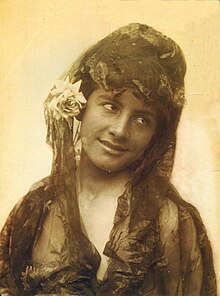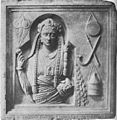Transvestism

Transvestism (also called transvestitism) is the practice of dressing and acting in a style or manner traditionally associated with the other sex.
History
Coined as late as the 1910s, the phenomenon is not new. It was referred to in the Hebrew Bible.[1] The word has undergone several changes of meaning since it was first coined and is still used in a variety of senses. According to some sources, the term transvestite today is considered outdated and derogatory.[2]
Origin of the term
Magnus Hirschfeld coined the word transvestism (from Latin trans-, "across, over" and vestitus, "dressed") to refer to the sexual interest in cross-dressing.[3] He used it to describe persons who habitually and voluntarily wore clothes of the opposite sex. Hirschfeld's group of transvestites consisted of both males and females, with heterosexual, homosexual, bisexual, and asexual orientations.[4]
Hirschfeld himself was not happy with the term: He believed that clothing was only an outward symbol chosen on the basis of various internal psychological situations.[3] In fact, Hirschfeld helped people to achieve the very first name changes (legal given names were and are required to be gender-specific in Germany) and performed the first reported sexual reassignment surgery. Hirschfeld's transvestites therefore were, in today's terms, not only transvestites, but a variety of people from the transgender spectrum.[3]
Hirschfeld also noticed that sexual arousal was often associated with transvestism. In more recent terminology, this is sometimes called autogynephilia. Hirschfeld also clearly distinguished between transvestism as an expression of a person's "contra-sexual" (transgender) feelings and fetishistic behavior, even if the latter involved wearing clothes of the other sex.[3] When speaking to or about an individual who identifies as transgender, the term transvestite is typically seen as derogatory.
Cross-dressers

After all the changes that took place during the 1970s [citation needed], a large group was left without a word to describe themselves: heterosexual males who wear traditionally feminine clothing. This group was not particularly happy with the term "transvestism", therefore the term "cross-dresser" was coined. [5] Cross-dressers are men who wear female clothing and often both admire and imitate women, but self-identify as different from both gay men and transsexuals, and generally deny having fetishistic intentions. As with the term 'transvestite', speaking of an individual who identifies as transgender as a 'crossdresser' would also be seen as a pejorative term.
When cross-dressing occurs for erotic purposes over a period of at least six months and also causes significant distress or impairment, the behavior is considered a mental disorder in the Diagnostic and Statistical Manual of Mental Disorders, and the psychiatric diagnosis "transvestic fetishism" is applied.[6]
Culture
In some cultures, transvestism is practiced for religious, traditional or ceremonial reasons. For example, in India some male devotees of the Hindu god Krishna, especially in Mathura and Vrindavan, dress in female attire to pose as his consort, the goddess Radha, as an act of devotion.[7] In Italy, the Neapolitan femminielli (feminine males) wear wedding dresses, called the matrimonio dei femminielli (marriage of the femminielli), a procession takes place through the streets, a tradition that apparently has pagan origins.[8]
Image gallery
-
Priest/priestess Archigallus of ancient Rome.
-
A 1927 photograph of Álvaro Echavarría ("El excluido") of Cúcuta, Colombia
-
Baron von Teschenberg, a German transvestite, one of the founders of the Scientific-Humanitarian Committee
-
A modern American transvestite.
-
A 19th-century photograph of a femminiello, an ancient culture of cross dressing in Naples, Italy
-
Seven men in a cabaret cast in Miami Beach in 1972, when two of them performed as women and three as transvestites
-
An example of a fictional transvestite; Bridget of the Guilty Gear series.
See also
- Cogender
- Cross-dressing
- Drag (clothing)
- I Am My Own Wife
- List of transgender-related topics
- Transgender
- Transsexualism
- Travesti (theatre)
- Dual-role transvestism
- Transvestic fetishism
Notes
- ^ Aggrawal, Anil. (April 2009). "References to the paraphilias and sexual crimes in the Bible". J Forensic Leg Med. 16 (3): 109–14. doi:10.1016/j.jflm.2008.07.006. PMID 19239958.
- ^ Thompson, Sarah. "Gender and Transgender in Modern Paganism page 118".
{{cite journal}}: Cite journal requires|journal=(help) - ^ a b c d Hirschfeld, Magnus: Die Transvestiten. Berlin 1910: Alfred Pulvermacher
Hirschfeld, Magnus. (1910/1991). Transvestites: The erotic drive to cross dress. (M. A. Lombardi-Nash, Trans.) Buffalo, NY: Prometheus Books. - ^ Hirschfeld, Magnus. Geschlechtsverirrungen, 10th Ed. 1992, page 142 ff.
- ^ Bullough, Vern L. Cross Dressing, Sex, and Gender. University of Pennsylvania Press, 1993. ISBN 0812214315
- ^ "DSM-V" (PDF). The DSM Diagnostic Criteria for Transvestic Fetishism. American Psychiatric Association. 2009. Retrieved February 4, 2013.
- ^ Meet the crossdresser saints of UP. CNN-IBN. Retrieved 21 January 2013
- ^ Il mondo del "femminiello", cultura e tradizione. TorreSette.it. Retrieved 21 January 2013
References
- Ackroyd, Peter. Dressing up, transvestism and drag: the history of an obsession. Simon and Schuster, 1979. ISBN 0671250914
- Mancini, Elena. A Brighter Shade of Pink: Magnus Hirschfeld. ProQuest, 2007. ISBN 0549700552
- Ambrosio, Giovanna. Transvestism, Transsexualism in the Psychoanalytic Dimension. Karnac Books, 2011. ISBN 178049307X
- Gravois, Valory. Cherry Single: A Transvestite Comes of Age (a novel) Alchemist/Light Publishing, 1997 (Available to read free, online), ISBN 0-9600650-5-9
Further readings
- Thanem, Torkild & Wallenberg, Louise (2016). "Just doing gender? Transvestism and the power of underdoing gender in everyday life and work". Organization 23(2): 250-271. dx.doi.org/10.1177/1350508414547559
External links
![]() The dictionary definition of transvestite at Wiktionary
The dictionary definition of transvestite at Wiktionary







